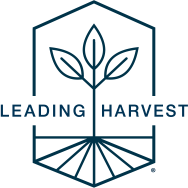Key Takeaways
In June 2023, Leading Harvest hosted an invitation-only Global Summit on Regenerative Agriculture in Chicago. The event brought together the organization’s global membership, representing almost 3 million acres in farmland management across the U.S. and Australia, for the first time to advance sustainable agriculture objectives and scale collective impact. The group represented some of the largest global food brands and agribusiness companies, millions of acres of land management, and billions of dollars committed to more sustainable food systems.
Among more than 100 attendees were farmers, nutrient and equipment companies, data and technology companies, and land managers sitting alongside pension funds and banks. This was a unique group of organizations that don’t typically come together in the same room, let alone engage in meaningful conversation about how their work can drive collective impact.
Of course, there are no straightforward solutions to the challenges facing our global food and agriculture systems. A one-day event cannot begin to solve their complexities. The unlikely combination of people at the event produced frank and fruitful conversations about obstacles that had not been discussed before – and it also raised a lot of questions and unknowns. These difficult questions are what will lead us toward a more sustainable and resilient future.
Below is a high-level summary of the main takeaways across the working session rooms. This is not meant to be an exhaustive list of all that was discussed, but rather to identify areas of agreement that hopefully spark more productive conversations, collaborations, and impactful solutions.
Questions? Want to get involved? Reach out to our Manager of Partnerships and Programs, Laura Robey, at lrobey@leadingharvest.org.
The sector must start with a common framework for sustainability.
Regenerative agriculture can mean different things to different people and organizations. One of the strongest themes of the Summit was that the sector must agree to a common framework for sustainability, including regenerative agriculture. What exactly is the food sector trying to move toward?
Generally agreed guidelines will enable the sector as a whole to track and measure progress, demonstrate the return on investment for growers, and implement at scale. This will also help to develop a baseline of sustainable management – a starting point. And, importantly, a common language will serve to break down silos and enable mutually beneficial partnerships and solutions across the value chain.
“We need a robust set of parameters, so we have confidence in what we’re putting money into.”
There must be better infrastructure for data collection and sharing.
It is no secret that there are significant barriers to sharing data across the food sector, especially at the farm level. This lack of infrastructure prevents transparency from one level of the supply chain to the next, which significantly limits the cross-sector partnerships and initiatives needed to drive real change.
Numerous attendees called for a standardized approach to data collection and sharing to better distribute value across the sector. For example, establishing and incenting a standardized data collection system can help to inform financing decisions. Sharing aggregated data and insights back to the grower can also help support and improve farm-level business decisions. Attendees also noted that because of the complexity and nuance of working with ecosystems, any approach to standardization must recognize qualitative data in addition to quantitative data.
Importantly, while a standardized approach is needed to build transparency and trust across the value chain, attendees emphasized that solutions risk eroding that same trust if issues of privacy are not addressed from the outset.
“On the farm level, producers aren’t immersed in data collection, quality, and standardization. How do we as an industry help growers think about that to get to the outcomes that we both want?”
Third-party verification will become a requirement for the food sector.
As the food sector makes more climate, sustainability, and regenerative agriculture commitments, more entities – from consumers to investors – are looking for verifications of claims. Self-reporting is not enough. Attendees agreed that the sector needs unbiased, independent third parties to validate, fact-check claims, and keep all parties accountable.
Third-party verification will be critical to building transparency and traceability in the food sector while also addressing the issue of data privacy and protection. This not only builds credibility on the consumer side but also between different entities in the value chain.
“Third-party verification is the only way any of this has integrity.”
Agricultural solutions must meet producers where they are, and with a clear value proposition.
In agriculture, change cannot be a top-down mandate. Already, many farmers and producers are becoming disillusioned by the food sector’s big promises around carbon claims and regenerative agriculture initiatives. Attendees emphasized the need for in-person grower education and peer-to-peer sharing around the benefits of sustainable and regenerative agricultural practices. Any solution that will be effective, according to attendees, must be developed alongside farmers and preserve farmer autonomy.
Attendees also agreed that the food sector is struggling to communicate a clear and consistent value proposition for farmers to adopt sustainable and regenerative practices. Better infrastructure for data collection and sharing can help to quantify the impact of these practices, building a case for the farmers’ return on investment.
“You can’t give farmers a solution and say good luck. The adoption of practices is harder than people think.”
The sector should celebrate shorter-term, incremental change.
Companies and organizations have made enormous climate commitments, including through sustainable and regenerative agriculture, but don’t have the tools to follow through. Accenture estimates that only 7% of companies are on track to achieve their net zero targets for scope 1 and 2 emissions, for example. A lack of progress and report-out risks disillusionment, both within the sector and with consumers.
Attendees agreed that broad 2030 and 2050 goals need frameworks and roadmaps to facilitate long-term transition strategies. Focusing on and celebrating incremental changes can be seen as more achievable to partners and farmers alike, helping to invite more folks into initiatives to drive greater collective impact.
“This sector has set goals that may be impossible to reach…Maybe part of this is figuring out how to reframe what we’re trying to do.”
Discussion about agricultural sustainability must include more than climate change and carbon sequestration.
Carbon reduction and net-zero goals are easy to latch onto because there are tools to measure outcomes, but attendees said that this is not enough. Across the rooms and in many different ways,attendees expressed the need to focus on broad-spectrum sustainability, expanding the scope of impact beyond environmental factors to also consider economic, social, and governance factors.
A landscape approach to sustainability, versus farm-by-farm, accounts for nature loss, biodiversity, and drought resilience in addition to regenerating communities and protecting workers. Attendees also pointed to nutrient density, not only looking at how ingredients are grown but also how they impact human health.
Tracking these markers of a truly sustainable ecosystem can also help to identify the ancillary benefits of sustainable and regenerative agriculture – in other words, build a concrete value proposition for growers.
“A climate-smart product is not necessarily a sustainable product.”
Solutions will not scale to any meaningful level without coordination across the value chain.
Right now, tremendous initiatives are occurring across individual companies and farms, but there is not enough recognition of these initiatives from one step of the supply chain to the next. The result is inefficiently allocated budgets and duplicate efforts. Often, multiple companies will target the same producers to join their individual programs.
Among our four breakout rooms – ag production, supply chain, finance and investment, and demand drivers – none of the sessions stayed entirely within their topic area. This isn’t surprising; these issues are too complex, interconnected, and interrelated to try to develop solutions in silos.
One of the core takeaways of the Summit on Regenerative Agriculture was that effective solutions truly require the entire food sector to come together. We need more uncomfortable conversations, unconventional partnerships, and alignment across the value chain to reach our shared goals.
“The supply chain needs to start talking to each other and quit being individualized … We have to partner at every step of the supply chain.”




